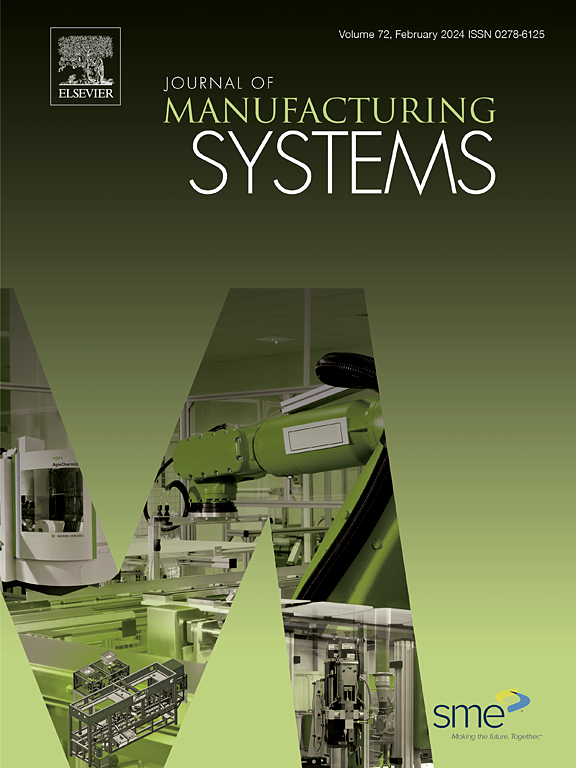Meta-knowledge triple driven multi-modal knowledge graph construction method and application in production line control with Gantt charts
IF 14.2
1区 工程技术
Q1 ENGINEERING, INDUSTRIAL
引用次数: 0
Abstract
Digital manufacturing involves complex and multidimensional interactions among production line resources, resulting in massive multi-modal knowledge. The knowledge often lacks correlation and contextual readability, leading to data silos. The rapid development of knowledge graphs (KGs) has rekindled interest in manufacturing knowledge engineering. Investigating the framework of multi-modal manufacturing data assets in enterprises and transforming them into a general-purpose KG database to support manufacturing processes is of significant importance. Guided by the principle of using KG as a manufacturing database, this study developed a multi-modal production line manufacturing knowledge graph (PLMKG) to support dynamic manufacturing on production lines. Firstly, the schema layer of the PLMKG is constructed using the Entity-Relationship model and a manufacturing knowledge pattern framework, with meta-knowledge triples proposed for schema data expression. Secondly, an event-state trigger dynamic instantiation method based on triples binding is proposed to enable self-growth. Third, a method integrating dynamic Gantt charts is introduced to synchronize the control of PLMKG and the manufacturing process. The anomaly detection model is employed to detect production, with the results stored in the PLMKG and Gantt charts for process control. Finally, a PLMKG prototype system for data management and process visualization is developed, with a 3D printing production line case study validating the construction and application of PLMKG. The results indicate that the proposed PLMKG integrates multi-modal manufacturing knowledge structurally and provides AI readiness for manufacturing, finally supporting the production line operation as a database.
元知识三重驱动多模态知识图构建方法及其在甘特图生产线控制中的应用
数字化制造涉及生产线资源之间复杂、多维的交互,产生海量的多模态知识。这些知识往往缺乏相关性和上下文可读性,导致数据孤岛。知识图谱(KGs)的快速发展重新点燃了人们对制造知识工程的兴趣。研究企业中多模态制造数据资产的框架,并将其转化为通用的KG数据库以支持制造过程具有重要意义。本研究以知识图谱作为制造数据库的原则为指导,开发了支持生产线动态制造的多模态生产线制造知识图谱(PLMKG)。首先,利用实体-关系模型和制造知识模式框架构建PLMKG的模式层,提出元知识三元组用于模式数据的表达;其次,提出了一种基于三元组绑定的事件状态触发动态实例化方法来实现自生长;第三,提出了一种集成动态甘特图的方法来实现PLMKG与制造过程的同步控制。利用异常检测模型对生产进行检测,并将检测结果存储在PLMKG和甘特图中,用于过程控制。最后,开发了一个用于数据管理和过程可视化的PLMKG原型系统,并通过3D打印生产线的案例研究验证了PLMKG的构建和应用。结果表明,所提出的PLMKG在结构上集成了多模态制造知识,并为制造提供了人工智能准备,最终作为数据库支持生产线运行。
本文章由计算机程序翻译,如有差异,请以英文原文为准。
求助全文
约1分钟内获得全文
求助全文
来源期刊

Journal of Manufacturing Systems
工程技术-工程:工业
CiteScore
23.30
自引率
13.20%
发文量
216
审稿时长
25 days
期刊介绍:
The Journal of Manufacturing Systems is dedicated to showcasing cutting-edge fundamental and applied research in manufacturing at the systems level. Encompassing products, equipment, people, information, control, and support functions, manufacturing systems play a pivotal role in the economical and competitive development, production, delivery, and total lifecycle of products, meeting market and societal needs.
With a commitment to publishing archival scholarly literature, the journal strives to advance the state of the art in manufacturing systems and foster innovation in crafting efficient, robust, and sustainable manufacturing systems. The focus extends from equipment-level considerations to the broader scope of the extended enterprise. The Journal welcomes research addressing challenges across various scales, including nano, micro, and macro-scale manufacturing, and spanning diverse sectors such as aerospace, automotive, energy, and medical device manufacturing.
 求助内容:
求助内容: 应助结果提醒方式:
应助结果提醒方式:


